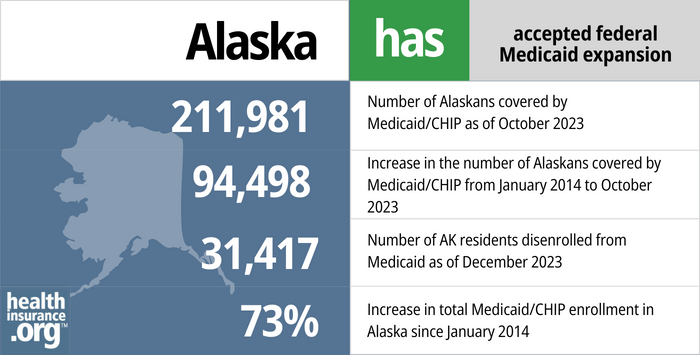
Medicaid eligibility and enrollment in Alaska
More than 71,000 are covered under Alaska’s expanded Medicaid eligibility rules that took effect September 2015

Who is eligible for Medicaid in Alaska?
Alaska’s eligibility guidelines for Medicaid were fairly generous for children, pregnant women, young adults (age 19 – 20) and parents, even before Medicaid expansion went into effect. However, non-elderly Alaskan adults without children were not eligible for Medicaid prior to September 1, 2015.
- Children from birth to age 18 are eligible if their family income is 203% or less of the federal poverty level (FPL).
- Pregnant women with family income of up to 200% of FPL are eligible (coverage for the mother continues for 60 days after the baby is born. HB59, under consideration in 2023, would extend that to 12 months. Most other states have already extended postpartum Medicaid coverage to 12 months)
- Because Medicaid has been expanded in Alaska, adults under age 65 are eligible with household income up to 138% of the poverty level.
See the FPL limits presented as annual income amounts, which vary based on family size (note that Alaska has its own poverty level, which is higher than the poverty level in the continental US and listed in the second table displayed at that link).
Aged, blind or disabled individuals who qualify for Alaska Adult Public Assistance (APA) also qualify for Medicaid.
for 2026 coverage
0.0%
of Federal Poverty Level
Apply for Medicaid in Alaska
Enroll online through my.alaska.gov or Healthcare.gov; submit a paper application by mail or fax to a local office; or call toll-free to schedule an appointment for assistance and enrollment.
Eligibility: Children up to age 18 if family income is up to 203% of FPL; Pregnant women with family income of up to 200% of FPL; And since September 1, 2015, other adults with family income up to 138% of FPL; blind or disabled individuals who qualify for Alaska Adult Public Assistance.

Did Alaska expand Medicaid?
Yes, Medicaid eligibility in Alaska was expanded under the Affordable Care Act (ACA), but not until September 2015. In most of the states that have expanded coverage, expansion took effect in January 2014, but the hold-out states have been slowly adopting Medicaid expansion over the years.
By April 2023, enrollment in Alaska’s expanded Medicaid had grown to 73,489. The U.S. Census Bureau reported that the uninsured rate in Alaska dropped from 18.5% in 2013 to 12.6% in 2018, and Medicaid expansion certainly played a role in that. Medicaid expansion enrollment grew sharply in the initial months and years after it took effect, and has grown again during the COVID pandemic.
- 211,981 – Number of Alaskans covered by Medicaid/CHIP as of October 20231
- 94,498 – Increase in the number of Alaskans covered by Medicaid/CHIP from January 2014 to October 20232
- 31,417 – Number of AK residents disenrolled from Medicaid as of December 20233
- 73% – Increase in total Medicaid/CHIP enrollment in Alaska since January 20142

Explore our other comprehensive guides to coverage in Alaska

If you need help understanding the Alaska Marketplace and choosing the right health insurance plan for you and your family, this guide is for you. For many, an Affordable Care Act (ACA) Marketplace plan may be a good option.


Looking for a brighter smile? Learn about dental coverage options in Alaska.


Nearly 113,000 Alaskans are covered under Medicare as of April 2023.4 Our guide answers your questions about Medicare enrollment in Alaska and how the state handles Medigap plans for disabled people under 65.


In Alaska, you can buy short-term health insurance plans that initially last up to 364 days. However, only one insurer currently offers short-term coverage in Alaska, and plans are capped at 185 days.

Frequently asked questions about Alaska Medicaid eligibility and enrollment
How do I enroll in Medicaid in Alaska?
The recommended way for most people to enroll in Medicaid in Alaska is online, through Healthcare.gov. But you can also enroll online through my.alaska.gov (click the link for “ARIES-Public Assistance”). You’ll need to create an account if you don’t already have one.
There is also an option to complete a paper application and submit it by mail or fax to a local office. Note Alaska uses a single application form for several programs; not all sections of the form are required to apply for Medicaid. Also, the form refers to a personal interview, which is NOT required for a Medicaid application.
Call a local office for enrollment assistance over the phone or to schedule an appointment for in-person assistance and enrollment. Both local and toll-free numbers are included on this contact list.
How does Medicaid provide financial help to Medicare beneficiaries in Alaska?
Many Medicare beneficiaries receive help through Medicaid with the cost of Medicare premiums, prescription drug expenses, and costs that aren’t covered by Medicare — such as long-term care.
Our guide to financial resources for Medicare enrollees in Alaska includes overviews of those programs, including Medicare Savings Programs, long-term care benefits, and income guidelines for assistance.
How is Alaska handling post-pandemic Medicaid renewals?
Throughout the COVID pandemic, states received additional federal Medicaid funding but could not disenroll anyone from Medicaid. The ban on disenrollments lasted from March 2020 through March 2023. States have a 12-month “unwinding” period, that could begin in February, March, or April 2023, during which they must redetermine eligibility for everyone enrolled in Medicaid. Under federal rules, disenrollments could resume as early as April 1, 2023.
Alaska chose to begin the unwinding process in April, with the first round of disenrollments coming at the end of May (coverage can be terminated prior to that if a person reports a change in circumstances to Alaska Medicaid, since the federal ban on disenrollments ended March 31, 2023).
People who lose their Alaska Medicaid will have the option to transition to an employer’s plan or Medicare (if eligible), or to a private individual/family plan obtained via HealthCare.gov. It’s important to submit the application for the new coverage before the date that Medicaid ends, in order to avoid a gap in coverage.
How many people are enrolled in Alaska Medicaid?
More than 264,000 people were covered under Alaska’s Medicaid and CHIP programs as of early 2023 (including those newly eligible due to Medicaid expansion, as well as those who were eligible under the prior guidelines). For perspective, total Medicaid/CHIP enrollment in Alaska at the end of July 2015 was 123,335. Two years earlier, in mid-late 2013, the total had been just 122,334; enrollment had grown very little prior to Medicaid expansion, but has grown considerably since then — due to Medicaid expansion as well as the COVID pandemic.
Legislation impacting Alaska Medicaid
Governor Walker moved forward with Medicaid expansion
The ACA allowed for Medicaid expansion starting in January 2014. But Alaska was one of the states that initially resisted expansion and continued to use pre-ACA eligibility guidelines for Medicaid, leaving about 10,500 non-elderly adult Alaskans in the coverage gap according to the Kaiser Family Foundation.
But Gov. Bill Walker (in office 2014 – 2018) took office Dec. 1, 2014, and expressed his commitment to Medicaid expansion in his first speech.
Walker’s administration hoped to launch Medicaid expansion by July 2015. However, technical problems with existing eligibility and payment systems were a barrier, and legislative support and funding presented additional challenges. Walker noted early on that he was willing to bypass the Legislature and authorize Medicaid expansion by executive order, but he tried various legislative avenues for Medicaid expansion during the first half of 2015.
With Alaska’s budget problem, triggered by the drop in oil prices, legislators warned that additional budget requests would be difficult or impossible to grant, and it’s no secret that Republican lawmakers in the state tend to be opposed to all things related to Obamacare. Lawmakers rejected the Medicaid expansion proposal that Walker included in his budget, and they didn’t vote on a bill that would have expanded Medicaid.
Ultimately, Governor Walker decided to expand Medicaid by executive order, and he announced his intent to do so on July 16. On July 21, the state health department hired a consultant to assist with the Medicaid expansion process and recommend how the state should proceed, both with expansion and with reforming the existing Medicaid program.
With Walker’s announcement, Alaska became the 30th state — 31st counting DC — to expand Medicaid (as of 2023, Medicaid has been expanded in 38 states and DC; this will grow to 40 states once South Dakota and North Carolina implement Medicaid expansion, expected in mid-2023 and early 2024, respectively). Walker’s proposal to accept $150 million in federal funding for Medicaid expansion was sent to the Legislative Budget and Audit Committee for their review, and the committee chair, Rep. Mike Hawker, gave a detailed account of how that process works. But Walker made it clear that he intended to proceed with Medicaid expansion regardless of the committee’s recommendation.
Medicaid expansion took effect despite a lawsuit from Republican lawmakers
In August 2015, Republican lawmakers announced they were filing a lawsuit against Walker over his decision to expand Medicaid. Walker noted that the lawsuit would cost the state about a million dollars, and expressed disappointment that the legislature chose that course of action. Lawmakers requested that the scheduled September 1 start date for Medicaid expansion be postponed while the lawsuit made its way through the legal system, but on August 28, a judge denied their request. And on August 31, the Alaska Supreme Court came to the same conclusion, refusing to delay the implementation of Medicaid expansion.
So on September 1, 2015, thousands of Alaska residents became newly-eligible for Medicaid, and were able to start enrolling in the program. In March 2016, the GOP lawmakers’ case was dismissed in Superior Court. But in May 2016, the Alaska House of Representatives filed an appeal. However, the proverbial horse was already miles from the barn, given that Medicaid expansion had taken effect months earlier, and the House dropped their appeal in June 2016.
Walker’s office said that roughly 42,000 people would be newly-eligible for coverage under the expanded guidelines. By February 2017, more than 30,000 had enrolled, and enrollment had reached more than 44,000 by August 2018 — slightly higher than initially projected, but still within the general range of expectations. But enrollment spiked during the COVID pandemic, as was the case nationwide (due to job/income losses as well as the requirement that states not disenroll anyone from Medicaid during the COVID public health emergency; that provision continued through March 2023).
In September 2018, three years after Medicaid expansion took effect in Alaska, Governor Walker expressed his ongoing support for Medicaid expansion, and reiterated how Medicaid expansion has been a financial boon to Alaska.
Representative Mike Hawker, a Republican from Anchorage, introduced HB219 in January 2016, to repeal Medicaid expansion if any of a variety of circumstances were to occur in the next five years. Hawker also introduced HB222, which would let the legislature control whether the governor could accept new Medicaid funds from the federal government. Neither bill passed in the 2016 session.
Alaska Medicaid history
Alaska’s Medicaid program is administered by the Department of Health and Human Service’s Division of Public Assistance (DPA).
The federal Medicaid program was established through Title XIX of the Social Security Act in 1965, with Alaska authorizing its program in September 1972.
While many states cover beneficiaries through Medicaid managed care, Alaska does not (the program does have a voluntary coordinated care initiative). The state is currently working to redesign and overhaul the existing Medicaid program to ensure that Alaska Medicaid can continue to provide high-quality health care in a manner that keeps the program sustainable for future generations.
Alaska did not expand Medicaid until September 2015, but enrollment grew significantly after that. By June 2016, total enrollment was 28% higher than it had been at the end of 2013. And by December 2016, it was up 42% over where it had been in late 2013. The COVID pandemic pushed Medicaid enrollment to record highs nationwide. In Alaska, total Medicaid enrollment was 115% higher by December 2022 than it had been in 2013.
In the first three years, from the fall of 2015 to the fall of 2018, nearly $1 billion in federal funding flowed into Alaska’s health care industry as a result of Medicaid expansion.
Footnotes
- ”October 2023 Medicaid & CHIP Enrollment Data Highlights” , Medicaid.gov, Accessed February 2024 ⤶
- “Total Monthly Medicaid & CHIP Enrollment and Pre-ACA Enrollment” , KFF.org, Accessed February 2024 ⤶ ⤶
- ”Medicaid Renewals Dashboard“, health.alaska.gov, Accessed January 2024 ⤶
- “Medicare Monthly Enrollment” CMS.gov, April 2023 ⤶

